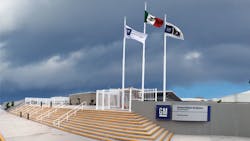Expansion Management: Why Are Automakers Pushing Further in Central Mexico?
GM (IW 500/4) has committed $691 million. Nissan (IW 1000/31) just spent $2 billion. Mazda (IW 1000/195) invested $650 million, while Honda (IW 1000/29) forked over $470 million.
What's the big attraction to Central Mexico? While the correct answer would be location, it's more about the ability to ship from this particular location that tips the scale.
Carlos Ghosn, CEO of Renault-Nissan Alliance, predicted last month that Mexico could soon be a bigger export hub than the company's home base of Japan.
And GM currently exports 10% of its Mexican production to South America.
The fact that Mexico has a total of 12 free trade agreements involving 44 countries is a big attraction for global auto companies. In addition to NAFTA, there are trade agreements with Chile, Colombia, Costa Rica, Nicaragua, Peru, Guatemala, El Salvador and Honduras. Additionally, Mexico has negotiated agreements with Israel, Japan and the European Union.
See Also: Manufacturing Plant Site Location Strategies
Honda is exploring all of its trading options, including the domestic Mexican market. "Considering the needs of the Mexican market, which is expecting continued growth in the future, and also serving as a global production base for the North American region and beyond, we decided to make the Fit the first product to be produced here," says Takanobu Ito, CEO of Honda Motor Co., Ltd., annoucing a new production facility in Guanajuato.
While new production facilities are opening, established ones are expanding. In fact, GM "has been key to the expansion of the automotive industry in Central Mexico," explains Oscar Forteza, GM's Mexico public policy director. "Proof of this is that in cities where we have installed manufacturing plants, great automotive production centers have been created after our arrival."
The Central Mexican cities benefitting from these production centers include Aguascalientes, Guanajuato, Queretaro, San Luis Postos and Zacatecas.
Just this past June, GM announced a $691 million investment that will be allocated to Guanajuato, San Luis Potosi and the state of Mexico. "These investments are to develop new-generation transmissions and expand our operations," Forteza says. "But I can tell you that in the past we have also updated our Ramos Arizpe Complex in the north of Mexico. So mainly, these investments respond to opportunities we have found in our production programs."
Central Mexico as a production base is already well on its way. This year the industry is expected to produce a record 3.15 million cars and 3.2 million light vehicles. The country already ranks No. 4 in exports (behind Germany, South Korea and Japan.) And by 2002, according to IHS, Mexico will produce one of every four vehicles in North America, up from one in six in 2012.
Along with OEM production comes a healthy supplier base.
"One of the major drives for Tier 1 and Tier 2 suppliers to enter the Central Mexico market was the insistences from OEMs that they located there," explains Doug Donahue, principal of the Entrada Group, which with works with Tier 1 and Tier 2 suppliers through a shared services, manufacturing model. In fact, in Guanajuato, suppliers Aki Seat, Daikyo Nishikawa and Tec Keylex moved in to service Mazda's plant that will come online in 2014, producing 140,000 vehicles.
Another advantage of the region is the workforce. "With the U.S. looking at a current skilled labor shortage and a future one as well, Mexico's young workforce [average age of 23] and the large number of engineering graduates provide distinct advantages."
| To learn more about auto activity in Central Mexico see industryweek.com/centralMexico |
Making sure those graduates are well trained, GM employs a strategy in Toluca to develop academic talent of young university students from Mexico City and the state of Mexico. "The most important thing is to continue to promote closer links between industry and schools to ensure that students acquire the knowledge and skills that businesses require," Forteza advises.

